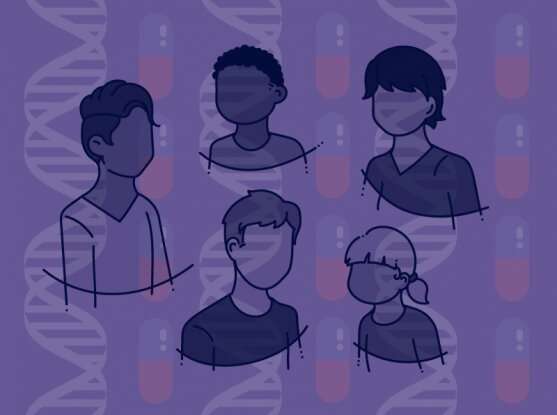Credit : Susanna Hamilton, Broad Communications
Most cancer drugs that target specific genetic mutations are designed for adult cancers rather than those in children, partly because pediatric cancers have fewer mutations. To look for more ways to target childhood cancers, researchers at the Broad Institute of MIT and Harvard, Dana-Farber Cancer Institute and Boston Children's Hospital decided to look for genetic dependencies in various pediatric cancers. These dependencies are key genes that cancer cells heavily rely on for growth and survival and are promising targets for new therapeutics.
Scientists from the Cancer Dependency Map (DepMap) project and their colleagues have identified new genetic dependencies for pediatric cancers, including many that are unique to these types of cancer. Their study, published in Nature Genetics, is the first comprehensive view of the differences in genetic dependencies between pediatric and adult cancers.
The unique dependencies found in pediatric cancers suggest new avenues for drug development for these cancers, several of which are treated with decades-old drugs. The authors say that given the differences in dependencies between adult and childhood cancers, repurposing adult cancer drugs for children will not be sufficient.
"One of our problems from a clinical perspective has been that, while a small number of children have benefited from matched targeted therapy, we don't see these matches at the same rate as we do in adult cancers," said Kimberly Stegmaier, an institute member and pediatric oncologist with the Cancer Program at the Broad Institute and co-director of the Pediatric Hematologic Malignancy Program at Boston Children's Hospital and Dana-Farber Cancer Institute. "We felt like this effort to map genetic dependencies in pediatric cancers was all the more important because we need to identify new targets for these cancers."
"This project has been such a great example of the pediatric oncology community coming together to partner with the Cancer Dependency Map team and the Broad's Genetic Perturbation Platform to lay what will undoubtedly be a new foundation for the field. I'm very confident that this effort will continue to bear fruit over the years ahead," said Todd Golub, a coauthor of the paper and director of the Broad.
The data are openly accessible through the DepMap portal, and the research team hopes that this dependency map is a useful resource for pharmaceutical companies and pediatric oncology researchers.
Childhood challenge
Childhood cancers have been a challenging area for new precision drug development not just because of the relatively small number of mutations in these cancers, but also because those mutations tend to be in genes encoding proteins that are difficult to target with drugs.
"But we know that there might be many genetic dependencies that are not associated with mutations, and so won't be discovered by just sequencing the genomes of cancer cells," said Francisca Vazquez, DepMap's scientific director at the Broad. "So we took a different approach. Pediatric cancer models were underrepresented in the cancer dependency map. To change this, we sourced pediatric cell lines from commercial and academic sources and created the largest collection to date," Vazquez said.
In their study, the scientists used large-scale CRISPR-based screens on 82 pediatric cancer cell lines, representing 13 types of solid tumor and brain cancers, to identify genes required for cell growth and survival. The team found that pediatric cancers had a similar number of genetic dependencies as adult cancers. Moreover, only about 64 percent of the genetic dependencies they found were common to both cancer types.
"We will need focused efforts around some drug targets that—at least based on this data—are relatively specific to pediatrics," Stegmaier said.
Among the results Stegmaier and her colleagues found most exciting were dependencies that were extremely specific to one type of cancer. For example, the team identified a gene called TRIM8 as a genetic dependency unique to Ewing sarcoma—a disease with cure rates still hovering at only 20 to 30 percent.
"When you find a gene, such as TRIM8, with a very strong dependency within a specific pediatric cancer, it is very exciting. One would predict that a therapeutic targeting this gene would have a high therapeutic window because none of the other cancer models were dependent on it," Stegmaier said.
Team effort
Stegmaier and Vazquez added that the thoroughness of this first-generation dependency map for pediatric cancers is a credit to the large-scale collaboration between researchers with expertise in pediatric diseases, CRISPR screening, computational biology, and project management.
"The expertises of the Cancer Dependency Map team in large-scale projects and the pediatric disease investigators were fundamental to the success of the project," Vazquez said.
"As a pediatric oncologist and computational biologist, it was especially rewarding to work on this project. Many of the childhood cancer patients we treat do not have effective targeted precision medicine options as these are mostly discovered for adult cancers, and our study has started to uncover exciting, new, pediatric cancer-specific opportunities for further research," said Neekesh Dharia, first author of the paper and a postdoctoral scholar in Stegmaier's lab.
Vazquez, Stegmaier, and their colleagues now plan to expand the map to include more types of pediatric cancer cell models—including those in brain cancers and rare leukemias that can be more technically challenging to study in the lab.
The team will also continue studying the data for more biological insight. "As we're digging into the data and looking at not just an individual gene dependency but multiple ones in the same networks, we start to really make connections," Stegmaier said. "The data allows you to understand basic mechanisms of pediatric cancer."
More information: Neekesh V. Dharia et al. A first-generation pediatric cancer dependency map, Nature Genetics (2021). DOI: 10.1038/s41588-021-00819-w
Journal information: Nature Genetics
Provided by Broad Institute of MIT and Harvard
























